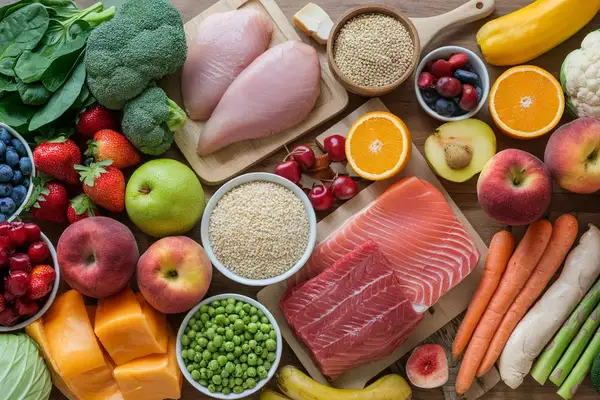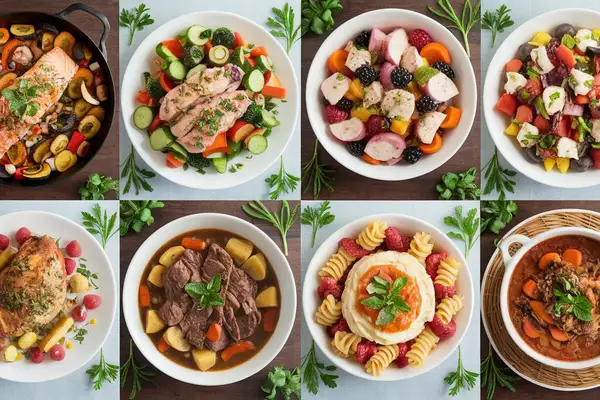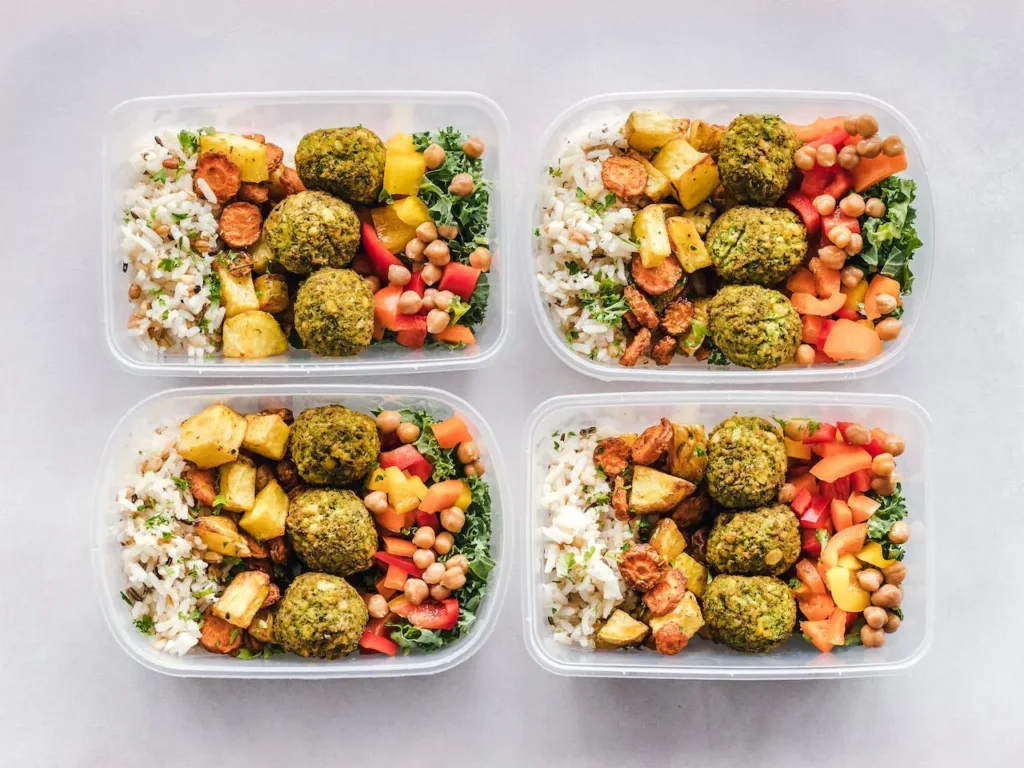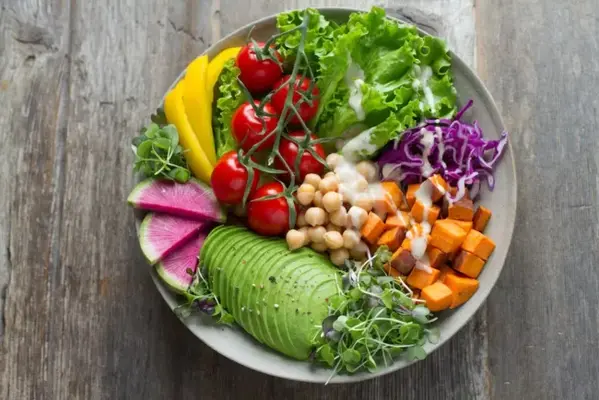Healthy 7 Day Renal Diet Meal Plan With Food List For CKD
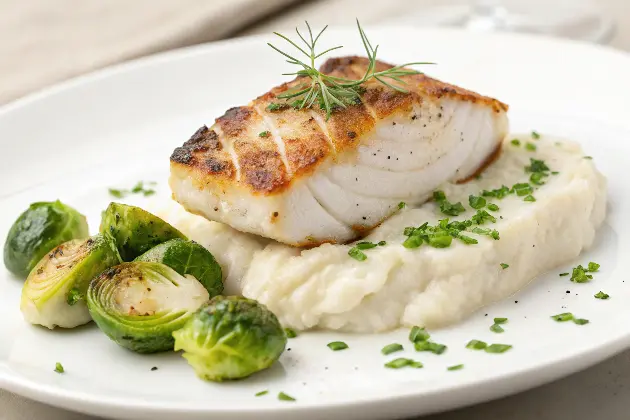
This post may contain affiliate links, meaning I may earn a commission if you make a purchase, at no extra cost to you. I only recommend products I trust. Thank you for your support.
Chronic kidney disease (CKD) is a condition that affects the kidneys’ ability to function properly, leading to a buildup of waste and fluid in the body.
Individuals with CKD must follow a nutrient-packed renal diet or chronic kidney disease diet food list to support their overall health and well-being.
What is a Renal Diet?
A renal diet, also known as a kidney-friendly diet, is a specialized eating plan designed for individuals with kidney disease.
This diet aims to manage and reduce the load on the kidneys by controlling the intake of certain nutrients, such as sodium, potassium, phosphorus, and protein.
A renal diet focuses on limiting certain nutrients such as sodium, potassium, and phosphorus, while ensuring an adequate intake of protein and other essential nutrients.
By carefully selecting and preparing meals, seniors can fuel their wellness and manage the progression of CKD.
7 Day Renal Diet meal Plan (Renal Diet Menu)
This 7 day renal diet meal plan incorporates a diverse selection of recommended fruits, vegetables, protein sources, grains, dairy, and dessert/snack options while aligning with the nutritional guidelines for a renal diet.
It includes renal diet foods breakfast lunch dinner ideas and renal diet recipes that are low in sodium, potassium, and phosphorus content.
Here is a detailed 7 day renal diet meal plan:
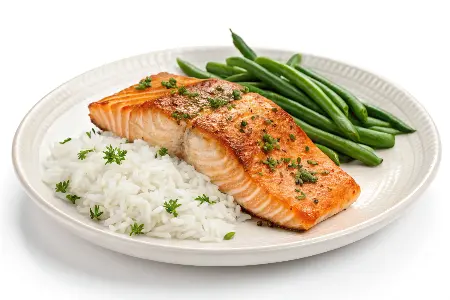
Day 1
Breakfast:
- Low-Potassium Smoothie: Smoothie made with almond milk, blueberries, and strawberries.
Lunch:
- Grilled Chicken Caesar Salad: Grilled chicken breast slices on romaine lettuce with a low-phosphorus Caesar dressing, parmesan cheese, and blanched green beans.
- Black Bean Tacos: Soft white flour tortillas filled with black beans, shredded cabbage or coleslaw, and cod fillets.
Dinner:
- Baked Salmon: Baked salmon fillet with a side of steamed green beans and white rice.
Snacks:
- Low-Sodium Crackers: Served with a small portion of cottage cheese.
- Apple Slices: Fresh apple slices with a sprinkle of cinnamon.
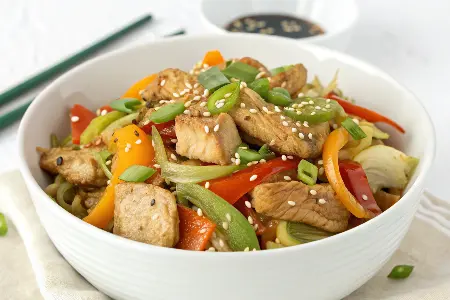
Day 2
Breakfast:
- Egg White Omelette: Egg white omelette with diced bell peppers and a side of white toast.
Lunch:
- Tuna Salad Sandwich: Tuna salad made with canned tuna in water, served on white bread with a side of carrot sticks.
- Cauliflower Rice Bowl: Cauliflower rice topped with grilled tofu and a side of green beans.
Dinner:
- Turkey Stir-Fry: Lean turkey breast stir-fried with cabbage and served over barley.
- Chicken & Veggie Soup: A hearty soup made with chicken breast, carrots, celery, and low-sodium broth.
Snacks:
- Popcorn: Unsalted, air-popped popcorn.
- Cottage Cheese: A small serving of cottage cheese with pineapple chunks.
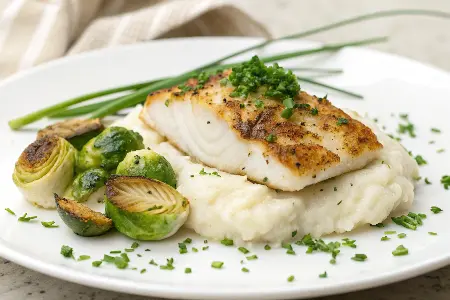
Day 3
Breakfast:
- Smoothie Bowl: A smoothie made with almond milk, spinach, and frozen berries, topped with fresh strawberries and chia seeds.
Lunch:
- Broiled White Fish: Broiled white fish fillet with a side of roasted Brussels sprouts and cauliflower mash.
Dinner:
- Chicken Stir-Fry: Chicken stir-fried with snow peas, carrots, and served over white rice.
Snacks:
- Nuts: A handful of almonds.
- Cucumber Slices: Fresh cucumber slices with a light ranch dip.
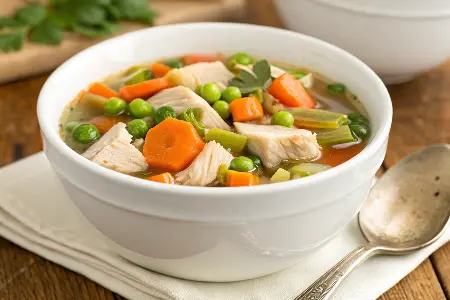
Day 4
Breakfast:
- Scrambled Eggs with a Twist: Scrambled eggs with spinach and served with white toast.
Lunch:
- Salmon Salad: Fresh salmon salad with lettuce, cucumbers, and a light lemon dressing.
- Chicken and Vegetable Soup: Hearty chicken and vegetable soup made with shredded chicken breast, carrots, celery, steamed peas, and herbs.
Dinner:
- Grilled Turkey: Grilled turkey breast with a side of steamed cauliflower and white pasta.
- Egg Salad Sandwich: Egg salad made with hard-boiled eggs and mustard, served on white bread with a side of carrot sticks.
Snacks:
- Fresh Fruit Bowl: A mix of watermelon, grapes, and assorted berries (blackberries, blueberries, strawberries, seedless cherries, raspberries).
- Carrot Sticks: Fresh carrot sticks with a side of hummus.
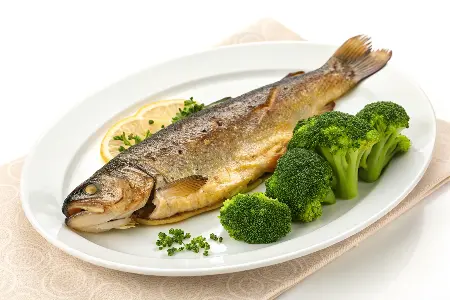
Day 5
Breakfast:
- Rice Milk Smoothie: Smoothie made with unenriched rice milk, fresh berries, and a banana.
Lunch:
- Chicken and Lettuce Wraps: Grilled chicken strips wrapped in large lettuce leaves with a side of low-sodium crackers.
Dinner:
- Spinach Salad with Grilled Tofu: Fresh spinach leaves topped with grilled tofu, cherry tomatoes, and a balsamic vinaigrette.
- Baked Trout: Baked trout fillet with a side of barley and steamed broccoli.
Snacks:
- Fruit-Based Pie: A small slice of apple pie.
- Greek Yogurt: A small bowl of Greek yogurt with a drizzle of honey.
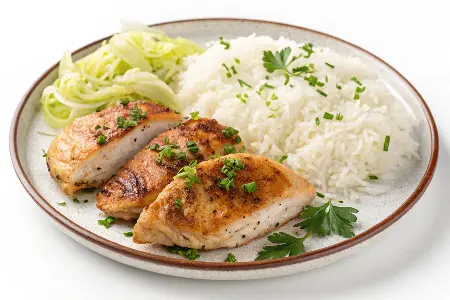
Day 6
Breakfast:
- Almond Milk Chia Pudding: Chia seeds soaked in almond milk, topped with fresh blueberries and a sprinkle of nuts.
Lunch:
- Egg Salad Sandwich: Egg salad made with hard-boiled eggs and mustard, served on white bread with a side of carrot sticks.
- Grilled Chicken Wrap: Grilled chicken strips wrapped in lettuce leaves with a side of low-sodium crackers.
Dinner:
- Baked Chicken and Rice: Baked chicken thigh with a side of white rice and steamed cabbage.
Snacks:
- Egg Whites: Scrambled egg whites with a side of fresh fruit slices.
- Apple Slices: Fresh apple slices with a light peanut butter dip.
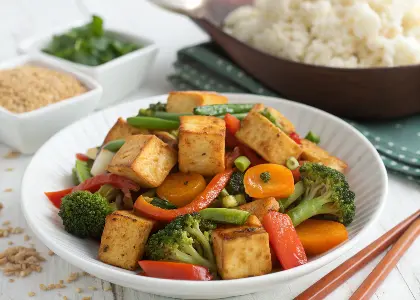
Day 7
Breakfast:
- Cottage Cheese with Pineapple: A bowl of cottage cheese topped with fresh pineapple chunks.
Lunch:
- Quinoa and Black Bean Salad: Quinoa mixed with black beans, corn, bell peppers, and a lime-cilantro dressing.
- Tofu Stir-Fry: Tofu stir-fried with bell peppers, served over white rice.
Dinner:
- Grilled Salmon: Grilled salmon fillet with a side of steamed green beans and barley.
- Salmon Caesar Salad: Grilled salmon served on a bed of romaine lettuce with Caesar dressing.
Snacks:
- Low-Sodium Crackers: Served with a small portion of low-fat cheese.
- Berries: Fresh strawberries and blueberries
Renal Diet Food List
This renal diet food list focuses on managing nutrient intake, especially phosphorus, potassium, sodium, and protein, to support kidney health.
Here is a detailed chronic kidney friendly foods or renal diet food list:
1. Fruits
- Apples: High in fiber and anti-inflammatory compounds. 1 medium apple with skin contains 0 sodium, 158 mg potassium, 10 mg phosphorus.
- Peaches: Low in sodium and phosphorus.
- Berries: Blueberries, blackberries, and strawberries are low in potassium and phosphorus.
- Pineapples: Contains substantially less potassium than other tropical fruits and can be a suitable alternative due to its lower potassium content.
- Cranberry Juice: An option for a lower potassium fruit juice.
2. Vegetables
- Carrots: Low in sodium and potassium.
- Cabbage: A low potassium and low phosphorus option.
- Cauliflower: Suitable for a renal diet due to its lower potassium and phosphorus content.
- Green Beans: Low in sodium and potassium.
- Lettuce: A low potassium and low phosphorus vegetable.
3. Protein Sources
- Chicken: A suitable lean protein option for individuals with CKD.
- Fish: Salmon, trout, tuna (fresh or canned in water), and other omega-3 rich fish are lower in phosphorus compared to other protein sources like red meat.
- Tofu: A lower phosphorus and potassium alternative to animal protein.
- Eggs: Can be included in moderation in a renal diet but may need to be moderated based on the prescribed protein intake.
- Turkey: A lean protein option that can be included in a renal diet.
4. Grains
- White Bread: Lower in potassium and phosphorus compared to whole wheat bread.
- White Rice: A lower potassium and phosphorus alternative to brown rice.
- Pasta: Whole grain or white pasta can be included in controlled portions.
- Oatmeal: A lower phosphorus grain suitable for a renal diet.
- Barley: Can be included in moderation due to its lower phosphorus content.
5. Dairy
- Greek Yogurt: A lower potassium and phosphorus dairy option that can be included in moderation.
- Cottage Cheese: Can be a part of a renal diet in limited amounts.
- Rice Milk (not enriched): A lower potassium and phosphorus alternative to regular dairy milk.
- Almond Milk: A suitable substitute for individuals looking for a lower potassium and phosphorus milk alternative.
- Low-Fat Cheese: Options like mozzarella and parmesan are lower in phosphorus and potassium compared to other cheeses.
6. Desserts and Snacks
- Low-Sodium Crackers: A lower sodium snack option for individuals with CKD.
- Popcorn: A low-sodium and low-phosphorus snack choice.
- Nuts: Almonds and cashews in limited portions can be included in a renal diet.
- Fruit-Based Pies or Cobblers: Options made with kidney-friendly fruits can be included occasionally.
- Cheesecake and Cookies: Can be included in controlled portions but should be mindful of overall phosphorus and potassium intake.
Foods To Avoid in a Renal Diet
Individuals with CKD should avoid certain foods due to their high levels of phosphorus, potassium, sodium, and protein, which can exacerbate kidney damage and contribute to complications associated with CKD.
Here are the renal diet foods to avoid:
1. Fruits
- Bananas: High in potassium, which can be harmful for individuals with CKD as it may contribute to hyperkalemia.
- Oranges and Orange Juice: Contains significant amounts of potassium and should be limited to avoid excess potassium intake.
2. Vegetables
- Potatoes: High in potassium and should be limited to avoid potassium buildup in the body.
- Tomatoes and Tomato Products: Contains potassium and phosphorus, making them less favorable for individuals with CKD.
3. Proteins
- Red Meat (Beef, Lamb, Pork): High in phosphorus and should be moderated to reduce phosphorus intake.
- Processed Meats (Bacon, Sausage, Hot Dogs): Often high in sodium and phosphorus and should be limited to manage sodium and phosphorus levels.
4. Whole Grains
- Whole Wheat Bread: Higher in phosphorus compared to white bread, and should be limited for individuals with CKD.
- Whole Grain Pasta: Contains more phosphorus than white pasta and should be consumed in moderation.
5. Dairy
- Regular Cheese (Cheddar, Swiss, American): High in phosphorus and should be limited to manage phosphorus levels.
- Chocolate Milk: Contains added phosphorus and should be avoided in a renal diet.
6. Snacks
- Packaged Snack Foods: Typically high in sodium and should be avoided or limited to manage sodium intake.
- Salted Nuts: High in sodium and should be avoided to manage sodium levels.
Health Benefits of a Renal Diet
A nutrient-packed renal diet plays a vital role in the well-being of individuals with CKD.
Here are the benefits of a renal diet:
- Protection from Kidney Damage: A renal diet helps protect individuals from kidney damage by controlling the intake of nutrients that can build up and damage the kidneys, particularly in the case of kidney disease.
- Nutrient Control: It aids in controlling sodium, potassium, and phosphorus levels, which are crucial for individuals with compromised kidney function.
- Maintenance of Electrolyte Levels: Following a renal diet meal plan may help promote kidney function and slow the progression of complete kidney failure by maintaining proper electrolyte levels.
- Kidney Disease Management: As chronic kidney disease advances, nutritional needs change, and a renal diet can play a vital role in managing the disease effectively.
- Weight Management: A renal diet helps monitor caloric intake, ensuring that individuals receive enough calories from nutritious sources, which is essential for maintaining a healthy weight.
- Nutritional Balance: A renal diet helps individuals maintain a healthy balance of salts and minerals in the body, supporting overall health and well-being.
- Balance Protein Intake: A renal diet ensures seniors consume an appropriate amount of high-quality protein to meet their needs without overburdening their kidneys.
Renal Diet Meal Prep Tips
By following these renal diet meal planning tips, individuals can make informed and healthy choices to support their kidney health.
1. Portion Control
- Pay attention to portion sizes listed on the package and estimate portion sizes by comparing them to the size of your hand or fist.
- Aim for 3-5 ounces of protein, 1/2 cup of fruits and veggies, and 1 cup of white bread and grains for a balanced meal.
- Consider fluid intake and remember that if you want to eat two serving sizes, all the nutrients and % DV will also double.
2. Enjoy Kidney-Friendly Meals All Day Long
- Commit to eating well for every meal, including breakfast, lunch, snacks, and dinner.
- Opt for protein-packed breakfasts, balanced lunches, and kidney-friendly versions of your favorite meals.
3. Know Your Kidney Health Needs
- Understand that with chronic kidney disease (CKD), your kidneys may not balance nutrients and waste efficiently, so it’s important to pay attention to nutrient intake and portion control.
4. Monitor Your Minerals
- Be mindful of your sodium, phosphorus, potassium, and protein intake.
- Opt for low-sodium, low-phosphorus, low-potassium, and high-quality protein foods to support kidney health.
5. Read Nutrition Labels
- Aim for more than 10% DV of dietary fiber and less than 10% DV of saturated fat, trans fat, sodium, and added sugars with each serving.
- Avoid foods labeled with “phos-” and use fresh fruits, vegetables, and proteins as much as possible.
6. Eat the Right Amount and Types of Nutrients
- Work with a dietitian to determine the right amount and types of protein, fat, and carbohydrates for your kidney-friendly eating plan.
7. Limit Sodium Intake
- Use herbs and spices for flavor, choose fresh or frozen vegetables, and avoid adding salt to your food.
8. Kidney-Friendly Recipes
- Consider including kidney-friendly recipes such as 6-grain hot cereal, broccoli, garlic and rigatoni, grilled pork fajitas, and many more.
9. Control Fluid Intake
- If your doctor has advised you to limit fluid intake, be mindful of consuming too many liquids, including soups, smoothies, and beverages.
Resources for CKD Individuals
Managing chronic kidney disease can be challenging, but there are resources and support groups available to provide guidance and emotional support.
Here are 5 such support groups:
- National Kidney Foundation (www.kidney.org): Provides educational resources, support groups, and advocacy for kidney disease patients.
- American Association of Kidney Patients (www.aakp.org): Offers resources, educational materials, and support for kidney disease patients and their caregivers.
- Renal Support Network (www.rsnhope.org): Provides support, education, and advocacy for kidney disease patients and their families.
- Caregiver Action Network (www.caregiveraction.org): Offers resources, support, and educational materials for caregivers of individuals with chronic illnesses.
Conclusion
A nutrient-packed renal diet is crucial for seniors with chronic kidney disease to maintain their health and well-being.
By connecting with these best nephrologists for personalized plans and utilizing available resources and support groups, caregivers can empower seniors to live fulfilling lives while managing their kidney disease.
Remember, a nutrient-packed renal diet is the cornerstone of wellness for seniors with chronic kidney disease.
Are you searching for a compassionate and experienced caregiver?
Check out my services and feel free to contact me here.
- 7-Day Meal Plan for Kidney Disease
- 7-day meal plan for Crohn’s disease
- Vegetarian Diet Meal Plan
- Vegan Food List
- 7-Day Meal Plan for Pancreatitis Recovery
- 7-day meal plan for seniors
- Find the best arthritis pain relief solution
- Christmas party buffet ideas
- Simple anti-inflammation diet recipes
- 7-day meal plan for Hashimoto’s disease
- Blue Zone meal prep tips
- 7-day DASH diet meal plan
Frequently Asked Questions (FAQs)
What is a renal-friendly meal?
A renal-friendly meal is one that is tailored to support kidney health, typically low in sodium, potassium, and phosphorus. It includes lean proteins like chicken or fish, whole grains, and kidney-friendly fruits and vegetables like apples and green beans.
Can you eat eggs on a renal diet?
Yes, eggs can be included in moderation on a renal diet. However, it’s important to monitor phosphorus intake as egg yolks are higher in phosphorus compared to egg whites. Opting for egg whites or consuming eggs in moderation can be a part of a kidney-friendly diet.
Can you eat bananas on a renal diet?
No, bananas are generally high in potassium (475 mg), so they are often limited on a renal diet.
Which fruit is best for the kidneys?
Berries such as blueberries, blackberries, and strawberries are considered best for kidney health as they are lower in potassium and phosphorus compared to other fruits. They are also rich in antioxidants and beneficial nutrients.
What foods cleanse the kidneys?
Foods that support kidneys include watermelon, berries, cabbage, cauliflower, fish rich in omega-3 fatty acids like salmon, and foods low in sodium, potassium, and phosphorus.
Additionally, staying hydrated by drinking an adequate amount of water is crucial for kidney cleansing.
What is the best protein for kidney disease?
Lean proteins such as chicken, fish (like salmon or trout), tofu, and egg whites are considered the best protein sources for kidney disease. These proteins are lower in phosphorus and potassium, making them kidney-friendly choices.
Which fish is good for kidney patients?
Fish high in omega-3 fatty acids, such as salmon, trout, and tuna (fresh or canned in water), are good choices for kidney patients. These fish are lower in phosphorus compared to other protein sources like red meat.
Is canned tuna good for kidney disease?
Canned tuna, especially tuna packed in water, can be a good protein option for kidney disease patients in moderation. It is lower in phosphorus compared to some other protein sources and provides essential nutrients like omega-3 fatty acids.
Resources
- Kidney-Friendly Eating Plan
- How To Build Your Kidney Meal Plan
- Impact of Plant-Based Diets on CKD Patients
Disclaimer: This article is for informational purposes only and should not be taken as medical advice. Reach out to support groups and healthcare professionals to access the information and assistance you need.
To learn more about managing chronic kidney disease and implementing a renal diet, visit the National Kidney Foundation website for valuable resources and support.
